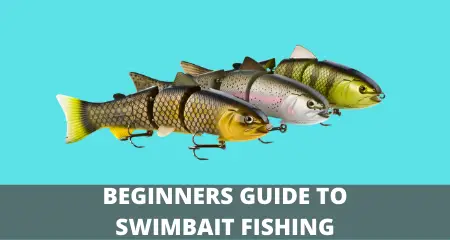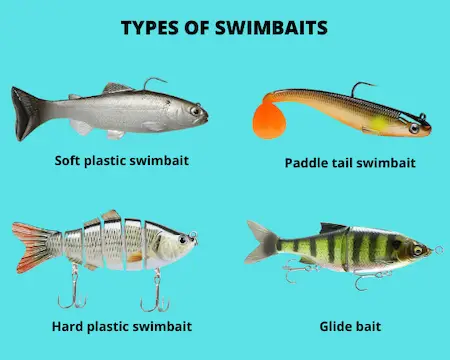Beginner’s Guide To Swimbait Fishing
UPDATED 03 NOVEMBER 2023
by Robert Ceran
Swimbait fishing has become immensely popular over the past decades, and consistently produces the most trophy bass in many fisheries.
But the biggest challenge with fishing swimbaits is that they come in a bewildering variety of types and sizes, and can be fished in many different ways.
So in order to get started with swimbait fishing, it’s important to have a firm grasp of the main types of swimbaits, what they are good for, and how you can use them to catch fish.

In this article we’ll cover the basics of swimbait fishing, what tackle you need to fish swimbaits, and how to put more fish in the boat with them.
What is a swimbait lure?
A swimbait is a type of fishing lure designed to resemble specific baitfish species very realistically, in order to trigger bites from predatory fish that feed on these baitfish.
Swimbaits were first made in the 1980s, and this first generation of swimbaits were built to look like rainbow trout. They were used to target largemouth bass and striped bass in reservoirs in Southern California, which are accustomed to feeding on stocked rainbow trout.
Nowadays, swimbaits come in a huge variety of sizes, shapes and colors, but all of these have in common that they are designed to resemble baitfish very realistically, which distinguishes them from other lure types, such as crankbaits and jigs.
Types of swimbaits
Swimbaits come in two main types: hard bodied and soft bodied swimbaits. But each of these types is further divided into subtypes, and as a result the overall category of swimbaits has become very diverse.
In the interest of simplicity, we’re just going to focus on the main types of swimbaits and a couple of their subcategories, which is plenty in order to get started with swimbait fishing.

The image above shows the 4 most commonly used types of swimbaits (soft bodied, hard bodied, paddle tail, and glide bait). If you know how to use these main types of swimbaits, you’ve got more than 90% of swimbait fishing covered.
Hard body swimbait subtypes:
- Multi-jointed swimbaits (with 2 to 10 joints)
- Single-jointed swimbaits (called glide baits)
Soft body swimbait subtypes:
- Paddle tail
- Wedge tail
- Split tail
Swimbait vs crankbait – what’s the difference?
The main difference between swimbaits and crankbaits is that swimbaits are very realistic imitations of specific baitfish species, while crankbaits are much less realistic.
Swimbaits are thus primarily designed to trigger bites from feeding fish, while crankbaits are more of a reaction bait.
Another difference between swimbaits and crankbaits is that crankbaits usually come with a lip, while swimbaits do not.
However, this difference is not absolute, as there are lipless crankbaits which have no lip, as well as some swimbaits that do have a lip.
What is a paddle tail swimbait?
A paddle tail swimbait is a type of soft bodied swimbaits with a large, flattened paddle at the end of its tail, which causes the entire tail region to wiggle vigorously during retrieval.
The great thing about paddle tail swimbaits is that they create their own action during retrieval, and are thus able to trigger bites even if you just pull them through the water without imparting any other action to them.
Is a fluke a swimbait?
No, a fluke is not a not a swimbait, but a soft plastic bait that can be rigged with different types of jig heads, hooks, and fishing rigs.
However, if you rig a fluke the right way, it can resemble a soft plastic swimbait, and can be fished similarly.
What fish are swimbaits good for?
Swimbaits are ideal for triggering bites from bass and other predatory fish, by presenting them with lifelike imitations of the baitfish species they are accustomed to feeding on.
For example, if you want to target largemouth bass in a pond, it’s best to use swimbaits that are bluegill imitations, since this is the main fish species that bass feed on in ponds.
Or, if you want to target largemouth bass in open water, it’s better to use swimbaits that resemble shad, trout, or kokanee (depending on the species that the bass are feeding on).
Are swimbaits good for bass?
Yes, swimbaits are great for bass, and were originally developed for bass fishing. They work well for both largemouth and striped bass, and are also used successfully for smallmouth bass fishing.
Do smallmouth bass eat swimbaits?
Yes, smallmouth bass eat swimbaits, but it’s generally better to use slightly smaller swimbaits if you want to target them specifically.
Choose your swimbait to resemble the most common bait fish that smallmouth bass are feeding on in your fishery (such as shad, minnows, perch, etc.).
What is the best swimbait?
According to popularity, the best hard body swimbait is the Bull Shad (handcrafted in the USA by Mike Bucca and his team), while the best soft body swimbait is the Huddleston Deluxe 68 (also handcrafted in the USA).
If you’re interested to learn more about the most important brands that produce swimbaits, check out our article: what are the top fishing lure brands?
What is the most expensive swimbait?
The most expensive swimbait is the Deniro Yugo Frame by Manifold, which retails at almost $1150. Coated with hand crafted leather, the Deniro Yugo Frame is 21 inches long and weighs 43 ounces.
This means you can only use it with a custom made rod, since regular swimbait rods can’t handle a lure this big.
When should you throw a swimbait?
The best time to throw a swimbait is when bass are actively hunting schools of fish.
The ideal times of year to throw a swimbait are fall, winter, and spring, since bass are often following around and hunting large schools of shad or other baitfish at this time of the year.
What kind of rod do you use for swimbaits?
For standard size swimbaits, use a 7’3” to 7’6” casting rod with medium power and moderate fast action. For large swimbaits use a 7’5” to 7’8” casting rod with heavy power and a lure rating of 1 to 4 oz, which covers the majority of swimbaits.
For extra large swimbaits or glide baits, you’ll need an 8’ extra heavy casting rod with a lure rating of 6 oz.
Can you use a crankbait rod for swimbaits?
Yes you can readily use a crankbait rod for smaller swimbaits under 2 oz, but this is not a good option for large swimbaits over 2 oz.
In other words, if you just want to try out swimbait fishing and explore it a bit, it’s definitely a good idea to start with smaller swimbait sizes and fish them with your crankbait rod.
But if you’re planning to get deeply into swimbait fishing, and want to use large swimbaits over 2 oz, it’s better to get a specialized swimbait rod that’s heavy enough to handle these lures.
What is the best gear ratio for swimbaits?
The best gear ratio for swimbaits is 5.3:1 to 6.3:1. This is a relatively slow speed baitcasting gear ratio, which is ideal for fishing swimbaits slowly.
However, you can also use a faster gear ratio baitcaster (up to 7.3:1), but then you’ll probably need to slow down your retrieve speed a lot in order to fish swimbaits slowly enough to trigger strikes.
What is the best line for swimbaits?
The best line for swimbaits is 10 to 15 lb test fluorocarbon. If you use extra large swimbaits or glide baits, you can even go up to 20 lb test fluorocarbon.
Fluorocarbon is better than braid for swimbaits because braid tends to snap if you get a bird’s nest while throwing a big swimbait. Since swimbaits are quite expensive, this is an annoying way to lose your lures, which doesn’t happen with fluorocarbon line.
Fluorocarbon is a better choice than monofilament for swimbaits because in the majority of cases you want them to sink in the water column, and since fluorocarbon sinks in the water this works well with fluoro (while mono floats on top).
What hooks to use for swimbaits?
For soft plastic swimbaits you should use either a jighead or a wide gap weighted hook. In either case, the hook should be big enough to pierce through both the swimbait plastic, and through the mouth of a bass.
Hard plastic swimbaits usually come with treble hooks already attached, but you can swap these out with bigger ones if you think that will improve the hook up ratio.
Keep in mind that the bigger the swimbait and its hooks, the easier it is for a big bass to shake off the hooks by jumping, so you’ll need to fight them hard and fast to avoid that.
What size hooks to use for swimbaits?
As a rule of thumb, use size 5/0 or 6/0 hooks for 5 inch swimbaits, 4/0 hooks for 4 inch swimbaits, and 3/0 hooks for 3 inch swimbaits.
While larger hooks generally don’t interfere with the action of a soft plastic swimbait, they can be conspicuous and spook fish, especially in clear water.
When should you use weighted swimbait hooks?
You should use weighted swimbait hooks when you want to target bass in deeper water, especially if you need to fish closer to the bottom.
A weighted swimbait hook also allows you to adjust the position of the weight on the shank of the hook, which you can use to control how the swimbait sinks in the water column.
If you place the weight close to the eye of the hook, the swimbait will sink down head first, while placing the weight towards the bottom of the shank will cause the swimbait to sink with its head up.
Can you Texas rig a swimbait?
Yes, you can definitely Texas rig a swimbait, and doing so will actually give you a very similar setup to what you get with a swimbait hook.
The main difference with Texas rigging is that you’ll have a sliding sinker rigged above the hook, which is generally better for fishing closer to the bottom, compared to using a swimbait hook.
